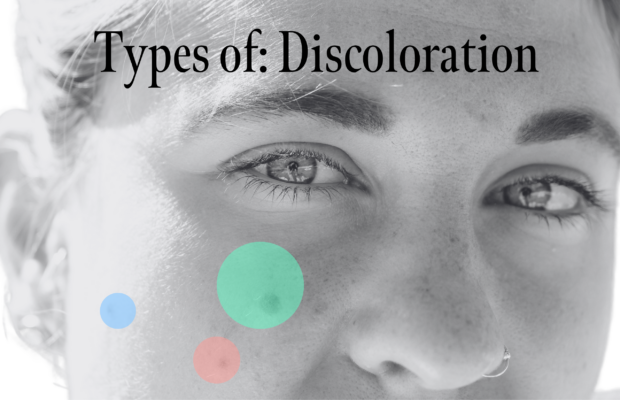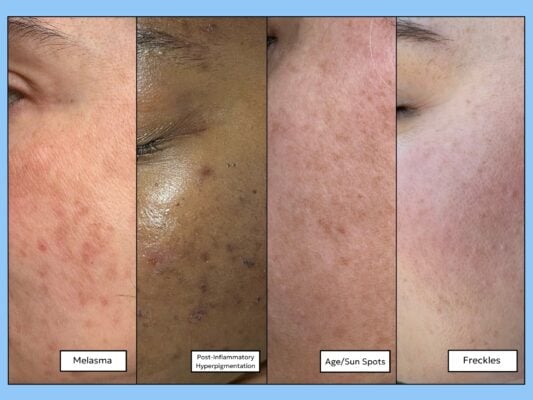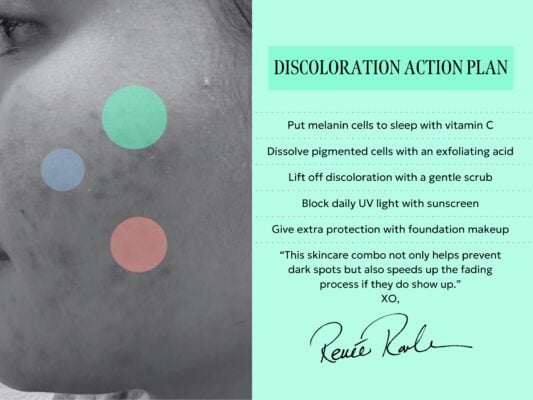Types of Skin Discoloration & How to Get Rid of Them Fast Leave a comment
As an Esthetician with 35 years of experience one of the questions I get asked most is, “How can I get rid of skin discoloration?” I get this from teens all the way up to seniors since discoloration affects most everyone. We all want our skin to look flawless without having to hide under makeup to get that even-toned look that we desire.
Let me quickly explain the causes of unwanted discoloration of skin and then we’ll get right into my expert action plan that will get you on your way to loving the skin you’re in.
What Causes Skin Discoloration?
Discoloration is an overproduction of a pigment called melanin. Genetics, sun exposure, hormones and injury to the skin (hello blemishes!) are the most common causes. Once the melanin factory turns on, it can be hard to calm fussy pigment cells back down. This is why it’s so frustrating because they can take months to go away – especially the deeper your skin tone is.
There are Four Types of Skin Pigmentation

Melasma
Large, dark brown and/or grayish patches that usually appear on the forehead, cheeks, or around the mouth. Melasma is usually caused from hormonal changes from menopause and pregnancy and for those taking birth control pills, too. In my professional experience, I never see it in the teen years, but see melasma most often for those in the 30’s for women (the pregnancy years).
Since the goal is to put melanin cells to sleep so they can fade, a lot of people work their skin into overdrive by over-exfoliating at home and getting too aggressive with chemical peels and microneedling procedures only to find that in doing so, they actually keep those cells awake. Their efforts to get rid of discoloration can often make it get worse.
I’m constantly telling people that we need to “put the fire out” so when we focus on calming and soothing skin inflammation, discoloration can start to fade. Sometimes, less is more with melasma.
Post-breakout marks
Also known as post-inflammatory hyperpigmentation (PIH) these are small, individual dark. red, purple spots that are left over from trauma to the skin, whether that was a blemish or even bug bites, cuts, or scratches.
The key to prevent post-breakout marks and scars is this:
Preventing breakouts from appearing in the first place. Easier said than done but consulting with a skincare professional who specializes in acne (like me!) can help you set up an action plan to help the type of acne you have because after all, not all breakouts are equal. As I wrote in this post, Tea Tree Oil can help with acne, can help a lot with blemish prevention. When a breakout appears, you MUST treat the blemish with the right spot treatment at the right stage of the life cycle. Read all about the life cycle of blemishes to prevent unnecessary discoloration.Don’t pick. Tempting, I know but it’s important to understand that you are creating a post-breakout discoloration that will last longer. Read how to stop your skin picking habit – once and for all.
I had a client who was a lifelong picker and you can see the damage that showed up even much later in life.
Age/Sun Spots
These range from light brown to dark brown in color and are a result of cumulative sun exposure brought to life starting most often in your 40’s since pigment cells rise to the surface with age.
Deeper skin tones are more prone to having more melanin in the skin so they will experience this more than lighter skin tones, but everyone will get this to a certain extent. So consider it just part of how the skin will inevitably show aging.
Discoloration from age does not just show up on the face, it can appear on the neck, too. There is a condition called poikiloderma and I personally deal with this. Read about the discoloration on my neck and how I improved it.
Then of course, the chest has to get in on the discoloration fun, too. I had a really, really bad sunburn once and the discoloration damage still shows up years later. See the sun damage on my chest.
Freckles
Small brown spots brought on during childhood — freckles are a genetic condition. When everyone is born, they come out of the womb with perfectly pigmented skin (you’ve never seen a baby with freckles, right?) but as early as age three for those genetically prone to them, they can start to appear once their skin is exposed to the sun.
People who have freckles somehow think they have more sun damage on their skin than those who don’t have them but this is simply false. Freckles, while a form of discoloration, are simply genetic from overactive melanin cells. One of your parents most likely has them and they seem to be most common in redheads.
It’s actually trendy right now for people to use makeup to get freckles, like my client Sabrina Carpenter who applies them to get that “cutesy” effect in this picture of us.
But like all discoloration, heat from the hot sun, saunas and steam room can exacerbate them.
My Discoloration Action Plan At Home
Okay, so now you know many of the ways that discoloration can be brought out, so now what? Through all of my education, training and having touched thousands of faces through the years, I have come up with the best strategy for home to, at the very least, keep discoloration from getting worse, but if you’re really diligent and committed, you absolutely should see visible improvement. My clients love the results they see with this plan and you should, too.
#1: Put melanin cells to sleep
When pigments show on the skin, they are in their active stage, and the goal is to encourage them to settle down. All the research shows that daily use of a vitamin C serum will help interrupt signals sent to melanocytes to help them fade more quickly.
But of course, you DON’T want to get a vitamin C acid burn, so I recommend a stable, no-sting using Tetrahexyldecyl Ascorbate (THD Ascorbate) like found in Vitamin C&E Treatment. This will quickly help interrupt signals sent to melanocytes.
#2: Dissolve unwanted pigment cells with an exfoliating acid
When applied to the skin, acids like glycolic, malic and lactic acids work to lower the pH of the skin and put it in an acidic state so discolored cells are dissolved and digested to allow for removal.
This includes leave-on overnight serums like Pore + Wrinkle Perfecting Serum or a once-a-week exfoliating treatment like Triple Berry Smoothing Peel.
#3: Lift off discoloration with a gentle scrub
This is KEY and often overlooked. Facial scrubs have gotten unpopular in recent years (here’s why) as acids gained popularity but as long as a scrub is gentle using round beads, when massaged over the face for 60 seconds, it truly gives instant gratification to lighten the appearance of pigment. These physical exfoliators are essential to use 2-3 times a week if you really want to see an improvement.
Triple Berry Smoothing Scrub is exceptional for instant brightening, and your skin will love it. (Skeptical of using a facial scrub? Read why scrubs are crucial for removing discoloration.)
#4: Block daily UV light with sunscreen – even when indoors
We all know the importance of daily sunscreen, but…you must use it during ALL daylight hours. So what does this mean? If you are in your home all day and daylight (even if it’s cloudy) is coming through windows and seeing your skin, it is keeping those unwanted pigment cells awake. Remember, the goal is to put melanin cells to sleep. Code word for…go away!
Where I see this the most is for oily, acne-prone skin types. They are afraid of using sunscreens since so many of them are heavy and loaded with oils and can lead to breakouts, so people will avoid them. But what if you could use a sunscreen that WON’T clog the pores? This is where Weightless Protection SPF 30 comes in.
#5: Give extra protection with foundation makeup
In the spirit of blocking UV light, did you know that makeup, even if it doesn’t say it has sunscreen in it, will act like sunscreen? This is because makeup is formulated with iron oxides, which are ingredients used in physical-blocking sunscreens. To ensure you are truly protecting your skin from having contact with damaging UV rays, think of foundation makeup as an extension of your skincare. I wear it during all daylight hours, no matter what.
If you’re someone prone to breakouts, foundations can be challenging as they are notorious for clogging the pores. See my favorite foundations for oily, acne-prone skin types.
So, there you have it. This is my best, at-home action plan to help get rid of skin discoloration faster.
Say hello to more even-toned skin — The Renée Way.
Celebrity Esthetician & Skincare ExpertAs an esthetician trained in cosmetic chemistry, Renée Rouleau has spent 30 years researching skin, educating her audience, and building an award-winning line of products. Her hands-on experience as an esthetician and trusted skin care expert has created a real-world solution — products that are formulated for nine different types of skin so your face will get exactly what it needs to look and feel its best. Trusted by celebrities, editors, bloggers, and skincare obsessives around the globe, her vast real-world knowledge and constant research are why Marie Claire calls her “the most passionate skin practitioner we know.”



